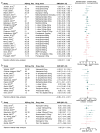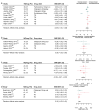Differential Associations of Dopamine and Serotonin With Reward and Punishment Processes in Humans: A Systematic Review and Meta-Analysis
- PMID: 40498519
- PMCID: PMC12159863
- DOI: 10.1001/jamapsychiatry.2025.0839
Differential Associations of Dopamine and Serotonin With Reward and Punishment Processes in Humans: A Systematic Review and Meta-Analysis
Abstract
Importance: Mechanistic biomarkers for guiding treatment selection require selective sensitivity to specific pharmacological interventions. Reinforcement learning processes show potential, but there have been conflicting and sometimes inconsistent reports on how dopamine and serotonin-2 key targets in treating common mental illnesses-affect reinforcement learning in humans.
Objective: To perform a meta-analysis of pharmacological manipulations of dopamine and serotonin and examine whether they show distinct associations with reinforcement learning components in humans.
Data sources: Ovid MEDLINE/PubMed, Embase, and PsycInfo databases were searched for studies published between January 1, 1946, and January 19, 2023 (repeated April 9, 2024, and October 15, 2024), investigating dopaminergic or serotonergic effects on reward and punishment processes in humans according to PRISMA guidelines.
Study selection: Studies reporting randomized, placebo-controlled, dopaminergic or serotonergic manipulations on a behavioral outcome from a reward or punishment processing task in healthy humans were included.
Data extraction and synthesis: Standardized mean difference (SMD) scores were calculated for the comparison between each drug (dopamine or serotonin) and placebo on a behavioral reward or punishment outcome and quantified in random-effects models for overall reward or punishment processes and 4 main subcategories. Study quality (Cochrane Collaboration tool), moderators, heterogeneity, and publication bias were also assessed.
Main outcomes and measures: Performance on reward or punishment processing tasks.
Results: In total, 102 studies conducted among healthy volunteers were included (2291 participants receiving dopamine vs 2284 receiving placebo and 1491 receiving serotonin vs 1523 receiving placebo). Dopamine was associated with an increase in overall reward (SMD, 0.18; 95% CI, 0.09 to 0.28) but not punishment function (SMD, -0.06; 95% CI, -0.26 to 0.13). Serotonin was not meaningfully associated with overall punishment (SMD, 0.22; 95% CI, -0.04 to 0.49) or reward (SMD, 0.02; 95% CI, -0.33 to 0.36). Dopaminergic and serotonergic manipulations had distinct associations with subcomponents. Dopamine was associated with reward learning or sensitivity (SMD, 0.26; 95% CI, 0.11 to 0.40), reward discounting (SMD, -0.08; 95% CI, -0.14 to -0.01), and reward vigor (SMD, 0.32; 95% CI, 0.11 to 0.54). By contrast, serotonin was associated with punishment learning or sensitivity (SMD, 0.32; 95% CI, 0.05 to 0.59), reward discounting (SMD, -0.35; 95% CI, -0.67 to -0.02), and aversive pavlovian processes (within-participant studies only; SMD, 0.36; 95% CI, 0.20 to 0.53).
Conclusions and relevance: In this study, pharmacological manipulations of both dopamine and serotonin had measurable associations with reinforcement learning in humans. The selective associations with different components suggest that reinforcement learning tasks could form the basis of selective, mechanistically interpretable biomarkers to support treatment assignment.
Figures





References
-
- Cipriani A, Furukawa TA, Salanti G, et al. Comparative efficacy and acceptability of 21 antidepressant drugs for the acute treatment of adults with major depressive disorder: a systematic review and network meta-analysis. Lancet. 2018;391(10128):1357–1366. doi: 10.1016/S0140-6736(17)32802-7. - DOI - PMC - PubMed
-
- Huys QJ, Daw ND, Dayan P. Depression: a decision-theoretic analysis. Annu Rev Neurosci. 2015 Jul 8;38:1–23. - PubMed
-
- Cardozo Pinto DF, Pomrenze MB, Guo MY, et al. Opponent control of reinforcement by striatal dopamine and serotonin. Nature. 2024 - PubMed
Publication types
MeSH terms
Substances
Grants and funding
LinkOut - more resources
Full Text Sources
Miscellaneous

